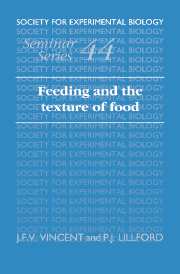Book contents
- Frontmatter
- Contents
- List of contributors
- Introduction
- Mechanical and fracture properties of cellular and fibrous materials
- Texture of plants and fruits
- Measuring meat texture and understanding its structural basis
- Food processing by mastication in cyprinid fish
- Quantitative aspects of the relationship between dentitions and diets
- The control of movements and forces during chewing
- The basic mechanics of mastication: man's adaptive success
- Integrating texture and physiology – techniques
- Brittle textures in processed foods
- The control and generation of texture in soft manufactured foods
- Texture and acceptability of human foods
- Index
Quantitative aspects of the relationship between dentitions and diets
Published online by Cambridge University Press: 14 January 2010
- Frontmatter
- Contents
- List of contributors
- Introduction
- Mechanical and fracture properties of cellular and fibrous materials
- Texture of plants and fruits
- Measuring meat texture and understanding its structural basis
- Food processing by mastication in cyprinid fish
- Quantitative aspects of the relationship between dentitions and diets
- The control of movements and forces during chewing
- The basic mechanics of mastication: man's adaptive success
- Integrating texture and physiology – techniques
- Brittle textures in processed foods
- The control and generation of texture in soft manufactured foods
- Texture and acceptability of human foods
- Index
Summary
The study of the systematic size reduction of solids poses special problems for mechanical analysis because the continually changing geometry of the loading between working surfaces of the equipment and the solid to be comminuted renders any exact stress analysis impossible. Even given that a stress pattern could be established, it is not at present possible to model stresses beyond the point at which a discontinuity (crack) starts to propagate in the solid, let alone the multiple and repetitive fracture which defines comminution; the shape and position of cracks and particle fragments cannot be specified. The chewing process is usually a comminution process and is additionally complicated by being masked by the cheeks. However, given sufficient information about the food input and the swallowed output coupled with static observations of the teeth in and out of the oral cavity of mammals, some aspects of the process become understandable. Given abundant information on dental morphology, the missing factor in the analysis of dentitions and diets is the almost total absence of knowledge of food texture.
This chapter concentrates more on food than teeth and emphasises work on primates because the behaviour and diet of these mammals has been studied intensively. Primates inhabit the tropics and subtropics forming a significant proportion of the arboreal animal biomass in primary rain forest (Terborgh, 1983). The vast number of animal and plant species in rain forest (Whitmore, 1984) affords the opportunity to study dietary selectivity, but with the drawback that complexity increases more than in proportion to the number of species in the environment because of the possibility of networks of coevolved plant–animal relationships.
- Type
- Chapter
- Information
- Feeding and the Texture of Food , pp. 93 - 122Publisher: Cambridge University PressPrint publication year: 1991
- 15
- Cited by



